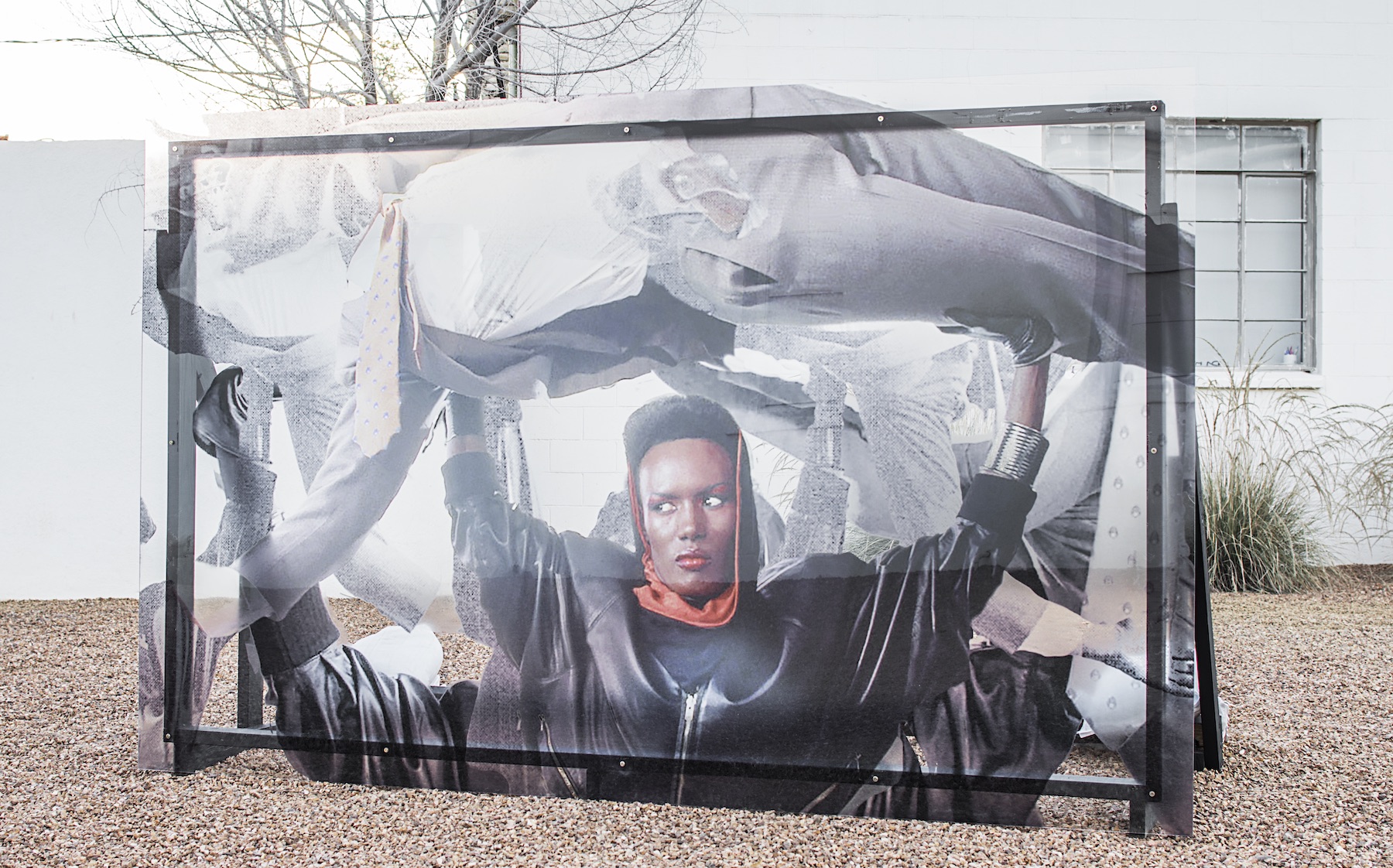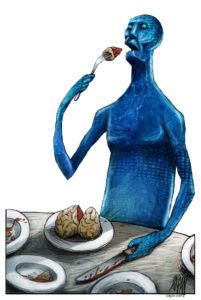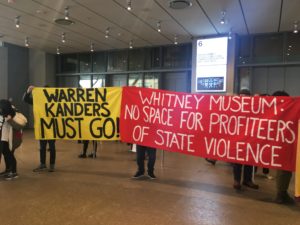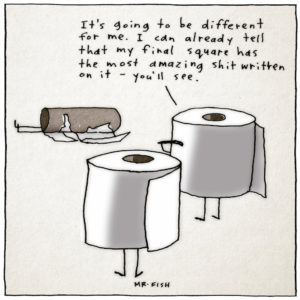Frieze L.A., The Sequel: Revenge of the White Patriarchy
Though diversity is a driving ethos of this year's event in Los Angeles, the art world is still deeply invested in sidelining people of color. Grace Jones in the 1985 James Bond film "A View to a Kill" inspired artist Jibade-Khalil Huffman, whose large-scale “May Day” is featured among Frieze Los Angeles artworks this year. (Image courtesy of Frieze Los Angeles)
Grace Jones in the 1985 James Bond film "A View to a Kill" inspired artist Jibade-Khalil Huffman, whose large-scale “May Day” is featured among Frieze Los Angeles artworks this year. (Image courtesy of Frieze Los Angeles)
Now in its second year, Frieze Los Angeles has taken over the lot at Paramount Studios. The opening act runs today through Sunday and anchors Frieze Week, a series of events, discussions and gatherings at galleries and art institutions around the city. The fair itself takes place in a tent designed by go-to art world architect Kulapat Yantrasast, a short walk from the special projects section, where commissions went to a cadre of emerging artists who took over the New York-style backlot with installations and other large-scale works.
The curators of special projects for Frieze Los Angeles are Los Angeles County Museum of Art’s Rita Gonzalez and the Vincent Price Museum’s Pilar Tompkins Rivas, who were charged with a mandate to embrace diversity. Black Lives Matter founder Patrisse Cullors is featured on the program to lead a participatory dance performance, while a look inside the wallets of everyday Brazilians makes Jonathas de Andrade’s video work an intimate and surprising portrait of his homeland. Gary Simmons was tapped to restage his 1993 “Backdrop Project,” taking Polaroids of visitors and offering them a copy.
“We really wanted to focus on the lack of Latino visibility in media, but also in the art world. There are very few commercial art galleries that represent Latinx artists, and that’s something we wanted there to be as a subtext to our selection,” Gonzalez tells Truthdig. “It was very strategic, the artists we were giving this platform to.”
Inside a faux-brownstone apartment, Vincent Ramos’ installation titled “Wolf Songs for the Dead” scrutinizes host Paramount Studios’ legacy of Latinx and Chicano representation in its movies. He mixes his own drawings, photos and personal family items with images scoured from the archives, including those of actors Anthony Quinn, Katy Jurado, Zorro, Lupe Vélez and Ricardo Montalban.
“Whoever is in charge, they don’t think these stories are worthy of being told,” says Ramos, a native Angeleno who lives and works in Venice. “Ask any brown person on the street, and they’ll tell you there are some pretty dynamic narratives from these cultures. Whether it’s the art world or the film world, those voices should be heard, because they are embedded in the history of this country. You can’t tell the history of the Southwest without Mexican Americans.”
That sentiment is echoed by the National Hispanic Media Coalition and the National Latino Media Council, which in 2018 boycotted the studio and staged a protest to emphasize its lack of Latinx representation. But Paramount isn’t the only culprit. Discrimination is industrywide, according to a recent USC Annenberg study, which found that Latinx representation has been cut in half over the last decade — dropping from 6% to 3%. This, when Latinx compose one-fifth of the U.S. population and roughly 25% of moviegoers.
The same problem persists in the art world. In a recent PLOS One study, researchers looked at more than 40,000 artworks in the collections of 18 museums across the U.S. and found that roughly 85% of artists represented are white, while 87% are men; 9% are Asian, 2.8% Latinx, 1.2% African American and 1.5% are listed under the catch-all of “other.” As for art markets, the top 20 most expensive artworks ever purchased were painted by white men. And of the names on Artnet’s 2014 “Most Expensive Artists list”, all but one belonged to whites.
Institutions are trying to change this dynamic, in some cases actually selling off works by white men to acquire works by women and people of color. In 2017, led by the J. Paul Getty Museum, museums across Southern California exhibited Pacific Standard Time: LA/LA, highlighting Latinx art in roughly 60 art institutions. The show was a second iteration of the 2011 exhibition, “Pacific Standard Time: Art in L.A., 1945-1980,” celebrating such midcentury practitioners as Ed Ruscha, Billy-Al Bengston and Larry Bell. In the months that followed, prices for their work jumped to new heights. According to Gonzalez, in the months following the 2017 exhibit, Latinx artists saw no such jump.
“It should have had a ripple effect that went everywhere. It’s not happening,” Ramos says. “A lot of us felt that would have told the narrative in a more substantial way. And it did for that moment, but then what’s next?”
Value is driven by the market, which generally consists of white people buying white artists. That means that while art lovers (most of them white) mill around Frieze Los Angeles’ special projects section taking selfies and admiring installations by people of color, when it comes time to make a purchase, they will go inside the main tent and buy works by such blue-chip artists as Cindy Sherman, Robert Longo and Doug Aitken.
“When black, brown, [people of color] faces are allowed into the spaces, it has to be figuration, it has to be narrative about some trauma. In fact, there’s much more of a demand to justify things that aren’t that,” notes Jibade-Khalil Huffman, whose large-scale “May Day” honors Grace Jones in the role of May Day, the villainous enforcer in the 1985 James Bond film, “A View to A Kill.” Hoisting a white man over her head, she is emblematic of a powerful black woman subverting a symbol of the white patriarchy. It’s an image that doesn’t jibe with mainstream expectations of narratives having to do with slavery and economic subjugation. Such pigeonholing shuts abstract artists of color out of the conversation entirely.
“My most immediate audience is people who look like me. But there are collectors who really do care about the work on its own terms. Not enough, though. We still need to burn the whole thing down and give out capital in different ways,” says Huffman, who currently has a show across town at Anat Ebgi. “But short of giving people access to museums, scholarships for people who can’t afford to go to art school, nothing’s going to change. Because of racism, we’re only going to allow the most obvious figurative art about slavery or some kind of traumatic thing in the door. That, for me, is a big part of it — the racism in that.”
Ramos wonders if museums could lead the markets in the direction of greater equity, especially in cities like Los Angeles, where Latinx far outnumber white people. “[The Los Angeles Museum of Contemporary Art] — hell, man, it’s a stone’s throw from East L.A., and a lot of those people are not represented in that museum,” he says. “To break free of this tokenism at some point would be fantastic, especially in this era of divisiveness. In a perfect world, these larger avenues of culture, film or the art world — they would make an effort to be more inclusive because of everything that’s going on. But that doesn’t seem to be happening, or it’s happening at a snail’s pace.”
Gabriella Sanchez has work both inside the main tent — at Charlie James Gallery’s booth — and on the backlot. Her triptych of vinyl banners titled “Hommes, Homes, Homes” is a play on the homonym using thematically connected imagery. “There are structural issues in the art world that haven’t been reworked or addressed as we become more diverse,” she says. “The art world is a microcosm of the larger world, with all the same issues. There are people who are genuinely interested in embracing diversity. But then I have also seen moments where there are institutions or people who are embracing it because of the moment. Obviously, I wish it was all genuine, but any movement is better than none.”
Your support matters…Independent journalism is under threat and overshadowed by heavily funded mainstream media.
You can help level the playing field. Become a member.
Your tax-deductible contribution keeps us digging beneath the headlines to give you thought-provoking, investigative reporting and analysis that unearths what's really happening- without compromise.
Give today to support our courageous, independent journalists.






You need to be a supporter to comment.
There are currently no responses to this article.
Be the first to respond.